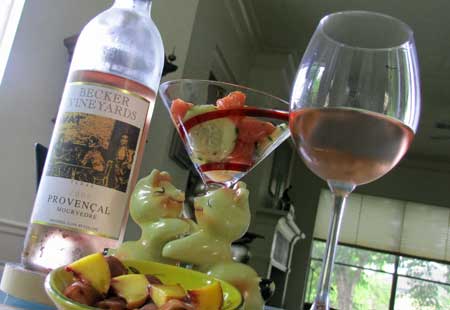Sunday ‘Cyclopedia of Wine: Rosé Wines
Rosé is simply the French word for “pink” which through the years has been assimilated into our English (and finally American wine) lexicon. True French-style Vin Rosé is not a blend of red and white wines. In fact, this process of making a Rosé is prohibited in France (except for pink or Rosé Champagne which can be made from a mixture of red and white grapes), as well as in some other countries. Vin Rosé is made from the fermented white juice from red grapes which is given limited contact with the red grape skins just long enough to achieve the amount and shade of color desired. The grapes are then pressed and the now-pink juice continues to ferment and is vinified as if it were a white wine.
Rosés are produced in many wine producing regions from a wide variety of grapes. Modern Rosés are also made by a variety of methods, in a range of residual sugar levels, and now some even include a mixture of juice from red and white grapes and the juice from grapes that bleed red juice (For example, in Texas, the French-American hybrid grape, Lenoir – aka Black Spanish).
Some of the classic Rosés include:
Rosé d’Anjou – A French off-dry to semi-sweet pink wine produced along the Loire River, in the Anjou region of France, from a range of grapes including Malbec and Cabernet Franc.
Rosato – Italian for Rosé. These pink wines are made throughout Italy and are available in varying styles. Light Rosés made in the northern region near Lake Garda are known as Chiaretto. Darker colored Rosés are marketed as Cerasuola which means “cherry colored”.
Rosado – Spanish for Rosé. Rosado is made mainly from red grapes. Nearly all types of Spanish red grapes are used although Garnacha (Grenache) is particularly suited due to it fresh, fruity qualities. The most unique Rosado in Spain is one made from the French grape, Petit Verdot.
The “Gold Standards” for dry Rosés are found in the tiny French appellation of Bandol AOC and on the western boundary of the southern Rhône River Valley in Tavel AOC. In Bandol, Rosés are magically colored a perfect salmon (pink-orange) hue, and offer interesting nuances of peaches, green grasses, and strawberry cream and mineral. Some of the best are from Chateau Pradeaux and Domaine Tempier and are comprised primarily of the juice from age-worthy Mourvedre grapes and garner prices upward from $75 a bottle. Tavel Rosés are a bit more economical and are made primarily from Grenache and Cinsault, but Syrah and Mourvedre may also be used. Interestingly, in the appellation of Tavel AOC, the wines made to the appellation are 100 percent Rosé.
— — — — —
If you are looking for a great Rosé wine experience a bit closer to home (in Texas), you are in luck….
Since Texas is a warm wine growing region like Bandol and Tavel, it has developed the ability to produce a wide range of Rosés made from the classic French varietals Grenache, Syrah and Mourvedre and from other grape varieties. Most range in sugar content from 0 percent residual sugar following fermentation (bone dry) to about 1 percent sugar (off-dry), however since there are many new wine drinkers in Texas, you can also find many semi-sweet versions (2-3 percent sugar) and some even sweeter that qualify as California-style “Blush” wines.
Award winning dry and near dry Rosés from Texas include:
Becker Vineyards Provençal (from Mourvedre)
McPherson Cellars Rosé (from Grenache and/or Syrah)
Messina Hof Sophia Marie Rosé (from Lenoir)
Perissos Vineyards Rosé (from Greneche and Cabernet Sauvignon)
Flat Creek Estate Rosé (from Sangiovese)
Driftwood Vineyards Rosé (from Syrah)
Texas Hills Vineyard Rosato (from Sangiovese)





Be the first to comment